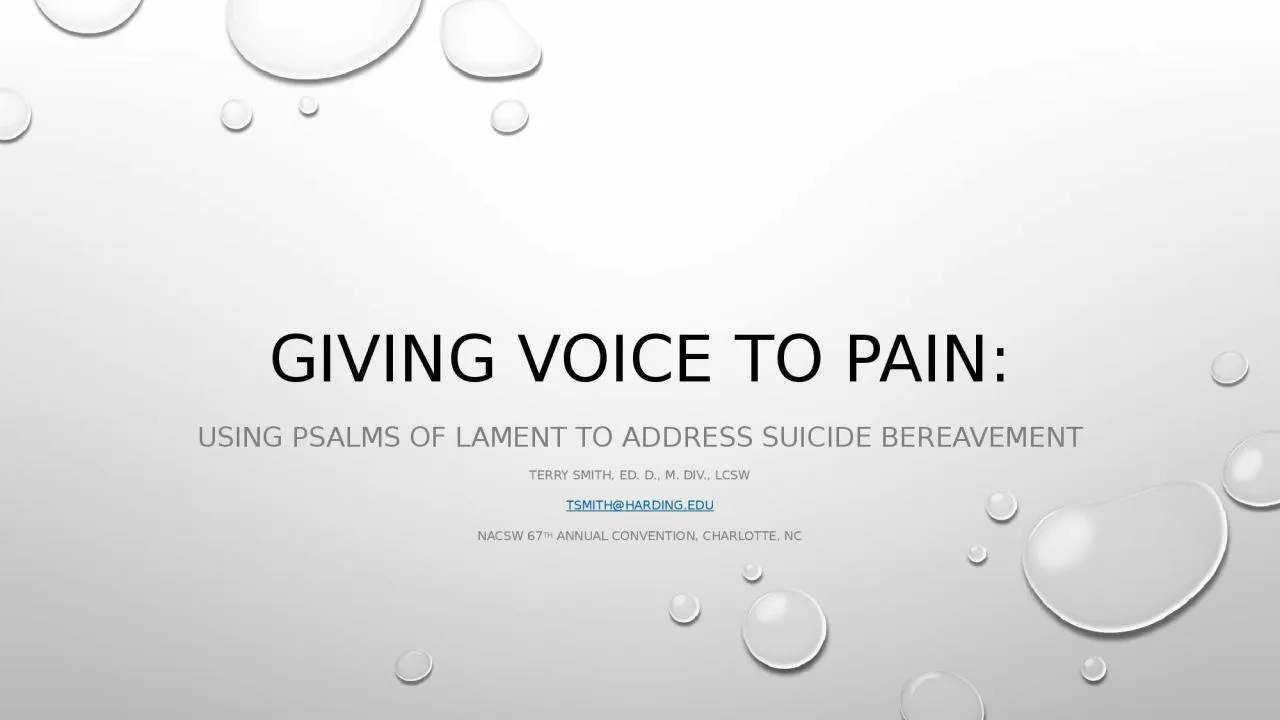

Terry Smith Ed D M Div LCSW tsmithhardingedu NACSW 67 th annual convention charlotte NC Grief is a whole person response to loss physical behavioral emotional cognitive and spiritual ID: 1044490
Download Presentation The PPT/PDF document "Giving voice to pain: Using Psalms of la..." is the property of its rightful owner. Permission is granted to download and print the materials on this web site for personal, non-commercial use only, and to display it on your personal computer provided you do not modify the materials and that you retain all copyright notices contained in the materials. By downloading content from our website, you accept the terms of this agreement.
1. Giving voice to pain:Using Psalms of lament to address suicide bereavementTerry Smith, Ed. D., M. Div., LCSWtsmith@harding.eduNACSW 67th annual convention, charlotte, NC
2. Grief is a whole person response to loss (physical, behavioral, emotional, cognitive, andspiritual).Death and non-death related lossesWorden (2009) identified four tasks of mourning a loss: - Accept reality of the loss - Process the pain of grief - Adjust to a world without the deceased - Find an enduring connection with the deceased in midst of embarking on a new life.Doka adds a fifth task: - Rebuilding faith and philosophical systems challenged by the loss (loss of assumptive world)
3. Factors that influence the grief reaction: -past experience with loss - current or past mental health - mode and timeliness of loss (cause of death; identity of deceased; sudden or expected; traumaticSocial support is positively linked with healthy outcomes
4. Unique Features of Death by SuicideDeliberatenessInvolvementLegacyMemoriesInvestigationFocusInsurance8. Embarrassment
5. Judgment/stigmaSelf-worthSelf-blameSilence and confusionMultiple lossesRelationshipsTerminologyPerceived as preventableAmbivalenceSupportRoss (1997)
6. Aftermath of Suicide (Clark, 2001)Over 1,000,000 worldwide yearlyFor every death, six others are severely affectedGreater risk for complicated bereavement - young person - bereaved parent or young widow - pre-loss stress - less emotional support - complications noted include depression, physical illness, anxiety, substance abuse, family breakdown
7. Church’s ReactionExcommunicationStigmatization/judgmental stance3. Denied burials in church cemetaries
8. Scarry (1985) acknowledges the difficulty in giving voice to pain.Pain is language shatteringSufferers need an honest language that allows vocalization of the loss (“ungagging the voice of the victim”)Psalms of LamentPsalms of lament provide words to rail about all that is unbearableTheir dominance in Psalms suggests that laments were voice regularlyLament: “the language of the painful incongruity between the lived experience and the promise of God” (Billman & Migliore, 1999).
9. Laments arise from times of trouble and express the fullness of human suffering with radical honestyBrueggemann (1977) says the main point is that life is not right nor what it was promised to be.Grief-stricken can use these laments as their own prayer to give voice to painLee (2010) encourages grievers to create their own lyrics and transform their pain into empowerment.Niemeyer (2009) suggests literary and narrative methods to express complex experiences:“Often the richly figurative speech afforded by poetry permits the bereaved to transcend the limits of literal language and give voice to intimate personal meanings and promoted their evolution in ways that sometimes surprise the poets themselves.”Laments have a cathartic value in that they encourage one to utter a cry but also provides the words to express it.
10. Laments validate and normalize the sadness, alienation, doubts, confusion, and bewilderment of the grief process.Difficult to see griever as subhuman after hearing his/her personal cry of lament.Encourage empathy.Laments can reduce the sense of isolation. Laments were a community event in ancient Israel.Laments are ritualistic and provide structure for the process of grief itself.
11. The form of the lament facilitates grieving and transformation: - cry of help - description of distress - appeal to God - reason for intervention - note of praiseStructured to move from sorrow to joy.
12. Original laments did not specify the conditions and can be adapted to fit the contemporary griever.Weems’ Psalms of Lament (1995)
13. Value of Psalms of LamentInvite one to listen to anguish without judgmentAttune one’s ears to hear anger, despair, and terror of othersAids one in “companioning” the bereaved (Wolfelt 2010)Gives a voice of hope in the midst of despair (spiritual survival)Jordan (2011) says suicide must become an acceptable topic in all of our social institutions
14. Articulation of pain must not be stifled, even in worship.Survivors of suicide must not be stigmatized.Survivors can embrace the words of sufferers from a previous generation to articulate their pain.Perhaps the Psalms of lament can also more fully equip those who seek to companion the survivors on their loss journey.
15. ReferencesBillman, K. & Migliore, D. (1999) Rachel’s Cry: Prayers of Lament and Rebirth of Hope Cleveland: United Church Press.Brueggemann, W. (1997) Costly Loss of Lament Journal for the Study of the Old Testament, 36, 57-71.Clark, S. (2001) Bereavement After Suicide: How Far Have We Come and Where Do We Go From Here? Crisis, 22, 102-108.Jordan, J. & McIntosh, J. (2011). Grief After Suicide: Understanding the Consequences and Caring for the Survivors. New York: RoutledgeLee, N. (2010). Lyrics of Lament: From Tragedy to Transformation Minneapolis: Fortress Press.Moore, M. & Roberts, D. (2017) The Suicide Funeral (Memorial Service): Honoring Their Memory, Comforting Their Survivors Eugene, Oregon: Resource Publications.
16. Niemeyer, R. Meaning Making in the Midst of Loss Grief Matters, 9, 62-65.Ross, E. (1997) After Suicide: A Ray of Hope for Those Left Behind. Cambridge: Perseus Publishing.Scarry, E. (1985). The Body in Pain: The Making and Unmasking of the World. New York: Oxford University Press.Weems, A. (1995). The Psalms of Lament Louisville: Westminster John Knox Press.Wolfelt, A. (2010). The Wilderness of Suicide Grief: Finding Your Way. Fort Collins: Companion Press.Worden, W. (2009) Grief Counseling and Grief Therapy: A Handbook for the Mental Health Practitioner, 4th ed. New York: Springer Publishing Company.
17.